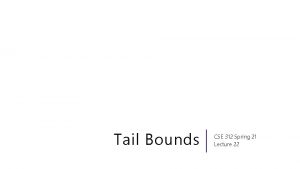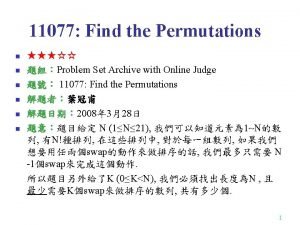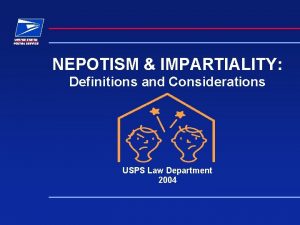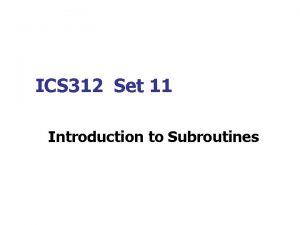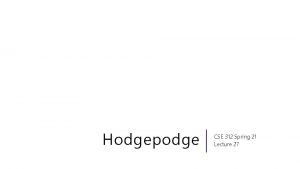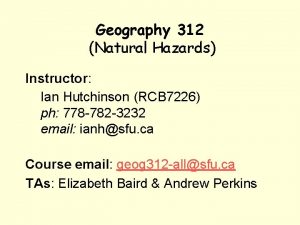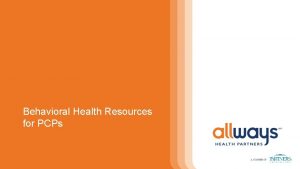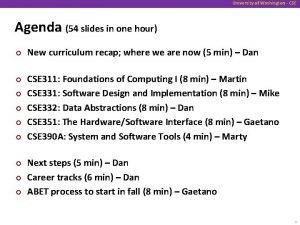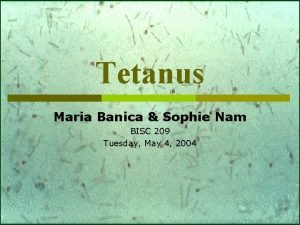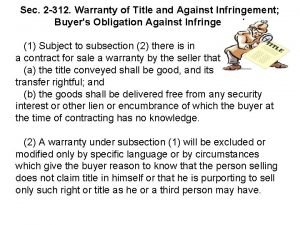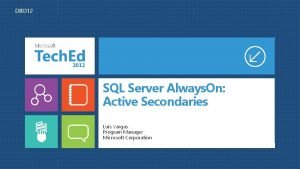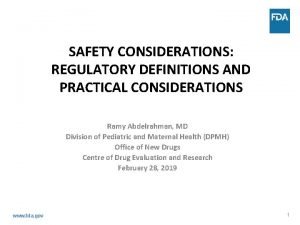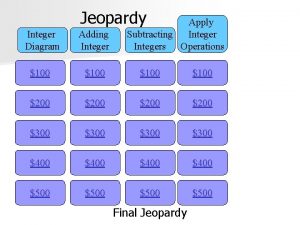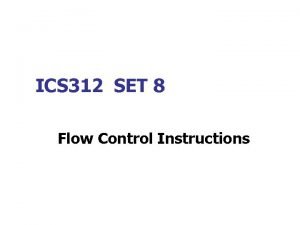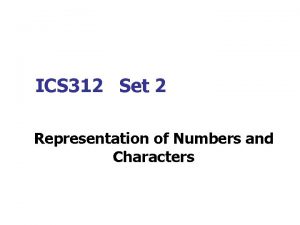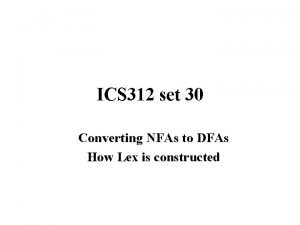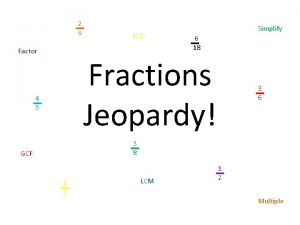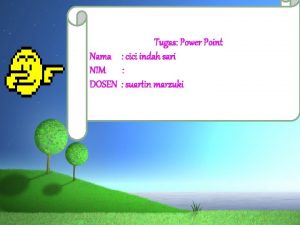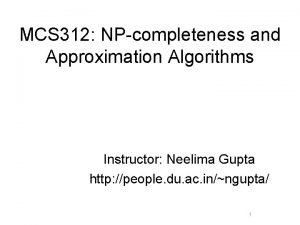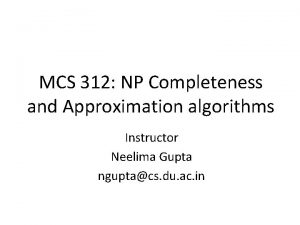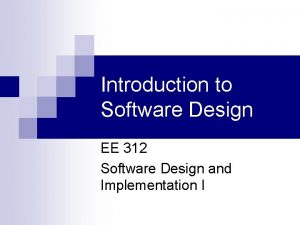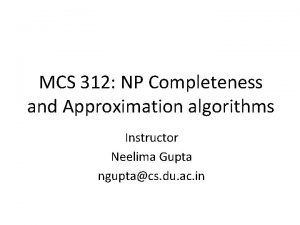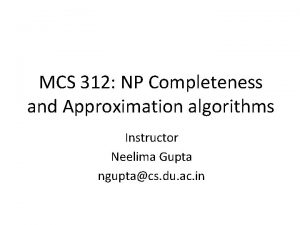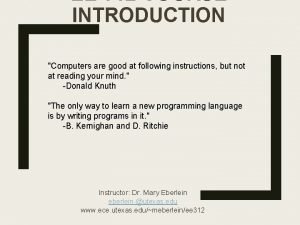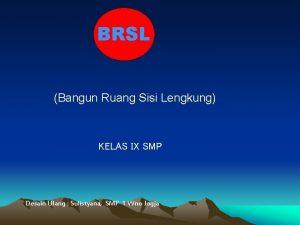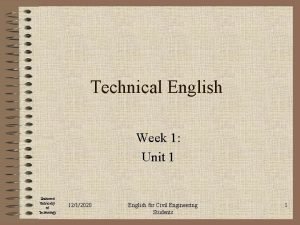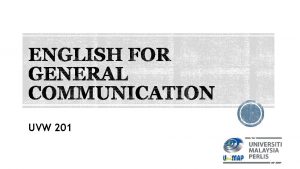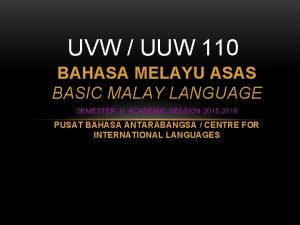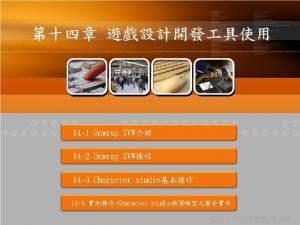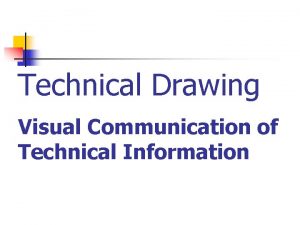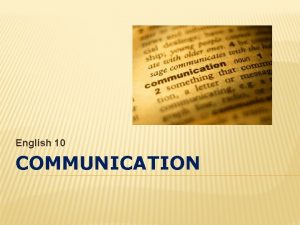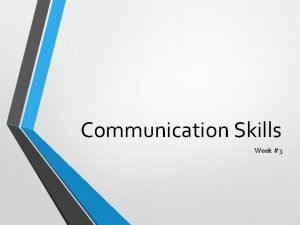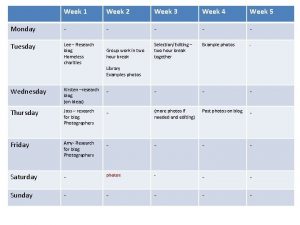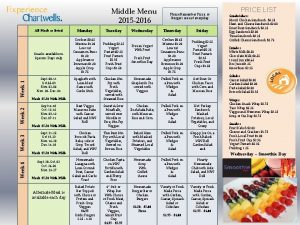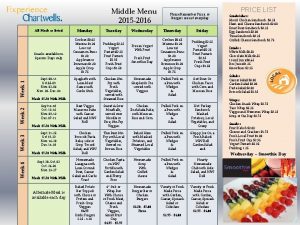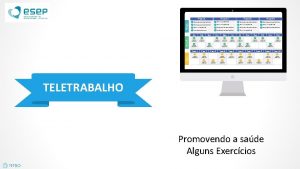UVW 312 English for Technical Communication WEEK 6























































- Slides: 55

UVW 312: English for Technical Communication WEEK 6 LECTURER: Centre for International Languages Semester 1, 2019/2020.

Report Writing

What is a report? • A systematic, well-organized document which defines and analyzes a subject or problems, which may include: – – – The record of a sequence of events. Interpretation of the significance of these events. Evaluation of the facts or result of research presented Decision of the outcomes of a decision or course of action. Conclusions. Recommendations.

Report • Reports must always be: – Accurate • Specific information and evidence presented are relevant to the topic. • All sources used should be acknowledges and referenced throughout the report. – Clear and Concise • The style of writing in a report is usually less discursive. • Use of direct and economic use of language. – Well-structured • The information is presented in a clearly structured format making use of sections and headings so that the information is easy to locate and follow.

Why do we write a report?

Reasons: Because we have to. Enable us to keep records. To keep on knowing what we are doing. To tell about successes and failures. To see the progress of something. To let other people know about the developments of a project. • Help researchers to do their work. • To determine further action. • • To use for evaluation.

Report Writing • A common form of workplace communication. • Report writing is an essential skill for professionals in many fields including business, science, education and information technology. • Mastering report writing at university will help to prepare you for your professional life.

Functions of Report Provide information Analysis • What are we doing NOW? • What we did LAST MONTH? • What our customer survey DISCOVERED? • What was DISCUSSED at the meeting? • What the PROGRESS of our project is? • What this information MEANS for us? • What course of action should be CONSIDERED? • What we RECOMMEND? • HOW GOOD is this product?

Reports vs. Essay Report Essay Function • Presents information. • Used to help to make decisions or account for actions. • Presents an argument. • Used to demonstrate knowledge, understanding and critical analysis. Structure • Specific sections using numbered headings and sub-headings. • May use graphics (tables, graphs, illustrations) • Continuous flow of text using minimal subheadings. • Rarely use graphics. • Rarely has recommendations or appendices.

The Structure of a Report

A report generally consists of: 1. Title Page – Normally include title, your name, and the name of the lecturer to whom it is being submitted, date of submission, your course/department and if applicable, the name of the person /organization who has commissioned your report.

2. Contents Page - A clear, well-formatted list of all sections and sub-sections of the report. 3. Summary - A general overview of the report. - Approximately 150 -200 words. - Highlights the problems or questions, research methods, findings and implications. - Avoid details or discussion: only outline the main points.

4. Introduction – – – The introduction sets the scene for the main body of the report. Explains the aims and objectives in detail. Outlines the sections in the body of the report. 5. Method – Explains about the tools used to collect information and the participants (if any). 6. Findings – This section should include a summary of the results of the research together with any necessary diagrams, graphs or tables gathered data that support your results.

7. Conclusion – Summarizes what the report achieved- did it meet the aims, the significance of the findings, discussion and interpretation of the findings. 8. References – A list of all the sources that you used.

Features of a Good Report… 1. Presented in an appropriate format. 2. Written in clear, concise and understandable manner (ABC’s of Revising). 3. FREE from grammatical error. 4. Effective use of headings. 5. Appropriate usage of graphics and visuals. 6. All graphics are labeled (correctly).

Types of Reports

Types of Reports Formal Reports Informational Reports Analytical Reports

FORMAL REPORTS • Have format: Title page Table of contents System of headings Reference or ‘works cited’ list Front-matter and end-matter supplements. • Require lengthy or in-depth discussion • Purpose: – – – • Solve problems • Make decisions • Give recommendation INFORMAL REPORT • Shorter • Require no extended planning • Prepared quickly • No or little background information • No front-matter or endmatter supplements. • E. g. : – memorandum

INFORMATIONAL REPORTS • Normally do not require any analysis of data. • Report routine matters and present an organized set of facts or findings based on a situation or problem. • In an organization, these reports help to transmit important day-to-day information by providing short and timely updates.

TYPES OF INFORMATIONAL REPORTS • TRIP REPORT – Gives an account of job-related travel. • PROGRESS REPORT – Documents the status of an activity, explaining what work has been accomplished and what work remains. • ACTIVITY REPORT – Recounts what had happen or taken place during a given period.

TYPES OF INFORMATIONAL REPORTS • MEETING MINUTES – Record the discussion that has occurred in a meeting. • INCIDENT REPORT – Documents an unexpected problem that has occurred, such as an automobile accident, equipment malfunction, fire, injury, etc. • LAB REPORT – Documents the status and findings from a laboratory experiment, procedure or study.

ANALYTICAL REPORTS • Usually lengthier than informational reports. • Offer information, interpretation and conclusions based on the information collected. • Preparing analytical report involves evaluating information, interpreting data accurately, drawing valid conclusions and making persuasive recommendations. • Presents answers or solutions to problems which are used later in the decision-making process.

TYPES OF ANALYTICAL REPORTS • FEASIBILITY REPORT – Examines the practicality of a proposed plan/suggestion using a set of criteria and then recommends action. – It looks at whether an idea, plan or course of action is realistic and practical. • RECOMMENDATION REPORT – Analyses several options and the recommends the best solutions. • EVALUATION REPORT – Reviews a situation, a product, a service, a procedure, etc. with a clear intention of judging its value by drawing inferences and forming conclusions.

TYPES OF ANALYTICAL REPORTS • INVESTIGATIVE REPORT – Analyses the causes behind an incident/problem and makes conclusions. – May also provides brief recommendation. • PEER-REVIEW REPORT – Provides a way for people (peers) to give each other constructive criticism and feedback.

EVALUATION REPORTS

Evaluation Reports • An evaluation report clearly, succinctly and impartially communicates all aspects of the evaluation. • AIM: to see the effectiveness of the items/ product/ service or programme. • Your evaluation report should include: – – – – Executive summary Introduction Evaluation methods Results Discussion of the results Conclusion and recommendation References Appendix

1. Executive Summary • Length: ½ a page or a page. • Provide OVERVIEW of the entire report (brief summary of the report) • What you need to mention in the executive summary ? – What do you evaluate? (Program/ Service) – Research method (data collection method) – Brief description of the respondents – Results ( for each section briefly) – Conclusion.

2. Introduction • Description about the program or service: • WHAT THE SERVICE/ PROGRAM IS ALL ABOUT? • WHO ARE USING THE SERVICE/PROGRAM? • IS THE SERVICE/PROGRAM VERY IMPORTANT TO ITS USERS? • WHAT DO THE USERS GET FROM THE SERVICE/PROGRAM? • You may include your secondary information here. – Any reading about the program/ service. – DO NOT DISCUSS about the results yet. • At the last paragraph, state your purpose of doing this evaluation report. (What is it that you want to evaluate? )

3. Methodology • METHODS that you use to gather information. • E. g. : – Primary – Secondary – Both primary and secondary. 1. Participants: • Who are your participants/ respondents? • Describe the participant using information derived from the DEMOGRAPGHIC PROFILE SECTION in the questionnaire. • How many participants involved? • Types of sampling methods used.

2. Questionnaire: – – The number of question asked The number of sections in the questionnaire The types of questions used The advantages of using a particular types of questions. • YOUR QUESTIONNAIRE: • Must include 3 sections: – Section A: Overview about the Program/ Service – Section B: Advantages/ Problems about the program/ service – Section C: Demographic profile of respondents.

4. Results • Report the data that you have collected from your questionnaire. • Present your data in tables, graphs or charts. • Summarize the findings. • Compare whether your findings matched with your purpose of evaluation or not.

5. Discussion of the results • Analysis and interpretation of the data collected from the survey. • State your opinion about the data collected. – Why do you think that the respondents choose to answer like this?

6. Conclusion • This section should not contain any new information but should RESTATE the findings concisely. • Provide conclusion for each aspects/ section of the program or service. • Make recommendation about the program effectiveness or suggest for improvement or changes based on the results.

7. References • Provide complete citations of any reports or publications cited in the body of the report. • Refer to page 120. • APA or IEEE reference style.

8. Appendix/Appendices • A section where you include all detailed documentation of points you outlined in your findings. – Data – Questionnaire – Table – Charts • Appendices act as supplementary information that you consider too long or complicated to be inserted in your report.

PROPOSAL REPORT

What comes to mind when you hear the word ‘PROPOSAL’?

Proposal Report • A “lifeblood” to the technical workplace. • Used to describe about new projects, present innovative ideas, offer new strategies, and promote services. • PURPOSE: present your ideas and plans for your readers’ consideration (to PERSUADE/CONVINCE your readers) • E. g. : – Proposal to use robots to automate the assembly line at a factory. – Proposal to request funding for the study on the effect of sonar on blue whale migrations.

• Proposal can be used “internally” or “externally” at workplaces.

Types of Proposal 1) INTERNAL PROPOSAL 2) EXTERNAL PROPOSAL - To persuade someone IN - To persuade someone OUTSIDE of the company 3) SOLICITED 4) UNSOLICITED - Asked for or requested by someone. - Nobody ask for it. the company/ organization.

Important Qualities for a Proposal Report. 1. Approach and manner of the report should be PERSUASIVE. 2. Highlights a problem by emphasizing the need to look into the problem. 3. Clearly describes both the PROBLEM and the SOLUTION. 4. Written in straightforward, easy to follow and understandable style. 5. OFFERS SOLUTION to a problem. 6. Ensure that the solution/ suggestion is REASONABLE and EXECUTABLE (by outlining the schedule, expertise needed, cost, etc. ) 7. Highlight the BENEFITS of the solution. 8. Highlight the STRENGTH and AREAS OF EXPERTISE processed. 9. Includes proper CITATION information of sources and contributors. 10. Uses VISUALS and GRAPHICS in an appropriate manner.

Proposal Report 1. Title page 1. Name of your university/ organization 2. Proposal title 3. Prepared by whom? 4. Prepared for whom? 5. Date of Submission 2. Table of Content - Ensure that the content are organized according to what is stated in the table of content. - Organize the content with systematic numbering/ appropriate bullet.

3. Executive Summary - ½ a page or one page. - Overview of the entire proposal report. - Provide brief summary of the following: a) Purpose of the proposal report b) Problems c) Solutions d) Benefits e) Management f) Cost g) Results h) Respondents i) Conclusion

4. Introduction – Begin your introduction by describing about the proposal. – WHAT is it that you want to propose? Is it a service or program? – PROGRAM: • • • What is the program about? What are the objectives of the program? Will the program be organized every semester or annually? How long will the program be? Will it be compulsory for students to attend the program? – SERVICE: • Where will the service be available? • How will the service supposed to help the students? – State the PROBLEMS that have been identified from not having the program or service by only mentioning the aspects of it. – Conclude by stating the purpose of writing the report.

5. Methodology – State the METHOD that you use in collecting information for the proposal report. Did you conduct a survey? Interview? Observation? – DEFINE the method that you are using. For example, if you choose survey, explain what is survey. Cite the information if you get the definition from somewhere else, using APA/IEEE format. – Justify why did you choose the method to collect your data. a. SAMPLING • • What type of sampling you are using? Is it Random or Purposive sampling? Based on the Demographic Profile section in your questionnaire, describe about your respondents: – – How many respondents were involved? How many male/female respondents? Age range? Program of study?

5. Methodology b. QUESTIONNAIRE • Describe about the questionnaire that you have designed: – The number of questions asked. – How is the questionnaire being organized in the questionnaire? Did you divide it into sections? – The types of questions used. Did you use only ONE type OR did you COMBINE several types of questions? Define each type of questions that you use. (Again, include a proper citation if you cite any. ) – The advantage of using this type of questions.

6. Problems • Describe in detail the PROBLEMS that you have identified that inspired you to propose the topic – E. g. : A Proposal to Set Up Students’ Learning Hub at Uni. MAP’s Main Campus – Problem 1: Language barrier for the international students in Uni. MAP. • Low proficient students having difficulties to comprehend the lectures conducted in English language. • Difficult to consult with the lecturers due to unable to communicate well in English language. – Problem 2: Finding suitable time to consult with the lecturers. • Uni. MAP students- always having packed timetable. • Difficult to find appropriate time to consult with the lecturers.

6. Problems • Support with the finding that you obtained from the survey. Did the respondents agree with the questions asked. • You can display the result in the form of graph/chart to support your statement. • Label the figures that you use with appropriate title. • Summarize the finding from the graph (apply what you have learn from Chapter 7: Data Interpretation)

7. Solutions • After you have decided on your problems, brainstorm with your group members and come up with THREE possible solutions to solve each problem. • Ensure that the solutions you suggested are logic and executable. • E. g. : – Problem 1: Language barrier for the international students in Uni. MAP. – Proposed solutions: • Provide English Courses for international students to improve their proficiency in English language. • Employ international staff who can communicate both in Arabic and English language. • Set up a student learning hub where students can personally consult with the tutors.

7. Solutions • Support your statements with the data you have obtained from the survey. If can be presented in the form of graph/chart. • Summarize the finding from the graph (apply what you have learn from Chapter 7: Data Interpretation)

8. Benefits - Identify the benefits of the proposed solutions as voted by the respondents. - Highlight the benefits for students’, staffs, and university’s perspectives.

10. Management - WHO will carry out the solutions. - WHAT can they do? - Can be Uni. MAP or outside organisation.

11. Cost - HOW much would it cost to imposed/ implement the solution? - Provide the estimation of the cost involved. - Written in a persuasive statement to convince readers to accept the solution.

12. Conclusion - Reflect from the questionnaire (what results did you find? ) - Restate the problems, the solutions and the benefits of the proposed solutions.

12. References - Cite your secondary information/ reading materials here. APA/ IEEE. 13. Appendix - Insert all materials you have used in completing your proposal report. - e. g. : A copy of questionnaire
 Eocr 내부결선도
Eocr 내부결선도 Rst 220v
Rst 220v Forms of technical communication
Forms of technical communication Week by week plans for documenting children's development
Week by week plans for documenting children's development Cse 312
Cse 312 123+132+321+312
123+132+321+312 Usps el 312
Usps el 312 Ics 312
Ics 312 Cse 312
Cse 312 Natural hazards definition ap human geography
Natural hazards definition ap human geography Java 8 312
Java 8 312 866-556-8166
866-556-8166 Cse 332 uw
Cse 332 uw Bisc 312 usc
Bisc 312 usc Altivar 312 solar
Altivar 312 solar 2-312
2-312 Ssis 312
Ssis 312 21 cfr part 312
21 cfr part 312 Bus 312
Bus 312 Redondear al numero cardinal mas cercano
Redondear al numero cardinal mas cercano What is the difference between 29 028 and 1 312
What is the difference between 29 028 and 1 312 What is the difference between 29 028 and 1 312
What is the difference between 29 028 and 1 312 Ics 312
Ics 312 Ics 312
Ics 312 Ics 312
Ics 312 2/9 simplified
2/9 simplified Lebar balok
Lebar balok Mcs 312
Mcs 312 Mcs 312
Mcs 312 Ee 312
Ee 312 Mcs 312
Mcs 312 Mcs 312
Mcs 312 Ee 312
Ee 312 Jika volume bangun ruang diatas 312 cm
Jika volume bangun ruang diatas 312 cm English 2 quarter 4 week 6
English 2 quarter 4 week 6 English 9 quarter 2 week 3
English 9 quarter 2 week 3 English week
English week English week objectives
English week objectives Iso 22301 utbildning
Iso 22301 utbildning Typiska novell drag
Typiska novell drag Nationell inriktning för artificiell intelligens
Nationell inriktning för artificiell intelligens Returpilarna
Returpilarna Varför kallas perioden 1918-1939 för mellankrigstiden?
Varför kallas perioden 1918-1939 för mellankrigstiden? En lathund för arbete med kontinuitetshantering
En lathund för arbete med kontinuitetshantering Personalliggare bygg undantag
Personalliggare bygg undantag Vilotidsbok
Vilotidsbok Anatomi organ reproduksi
Anatomi organ reproduksi Densitet vatten
Densitet vatten Datorkunskap för nybörjare
Datorkunskap för nybörjare Tack för att ni lyssnade bild
Tack för att ni lyssnade bild Att skriva en debattartikel
Att skriva en debattartikel Autokratiskt ledarskap
Autokratiskt ledarskap Nyckelkompetenser för livslångt lärande
Nyckelkompetenser för livslångt lärande Påbyggnader för flakfordon
Påbyggnader för flakfordon Kraft per area
Kraft per area Svenskt ramverk för digital samverkan
Svenskt ramverk för digital samverkan




